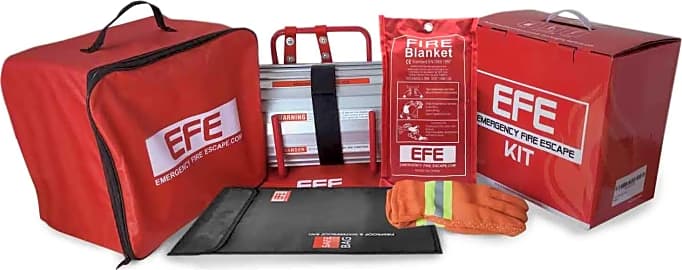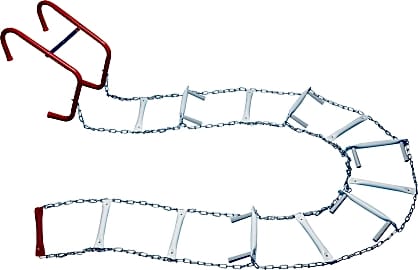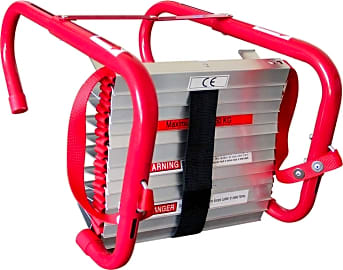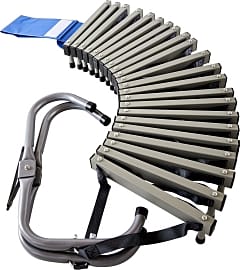The 8 Best Escape Ladders

This wiki has been updated 40 times since it was first published in July of 2015. Don't wait until a fire puts your family or employees in harm's way. Equip your home or workplace with one or more of these escape ladders to ensure that everybody has an alternate path to safety when an emergency strikes. Our selections for this category include everything from short options suitable for two-story houses to models for low-rise apartments, that are longer than 50 feet . When users buy our independently chosen editorial selections, we may earn commissions to help fund the Wiki.
Editor's Notes
April 20, 2021:
This list still looked to be in good shape, with all of our previous picks still presenting as sensible selections with good availability, and so we saw no need to remove any of our existing rankings from this list. We did, however, add the Efe Emergency Kit, which, in spite of having a lower weight capacity than some alternatives, earned a top spot, thanks to the useful inclusion of a fireproof bag, a fire blanket and a pair of heat-resistant gloves.
For solutions to help keep your family safe away from home, you might also be interested in checking out our lists of emergency road kits, emergency lights and emergency shovels.
February 20, 2020:
While all of our existing selections managed to maintain their positions during this round of updates, we did add one new option to our rankings for this category: Although the Safedeal Flame Resistant is limited by its 16-feet length, and could take considerably longer to deploy than alternatives – in a situation when seconds count, we thought that it still merited a mention, based on its reasonable price and impressive 2,500-pound load capacity.
A few things to look for in this category:
Length and Capacity: This might seem like a self-explanatory consideration, but that doesn’t stop it from being an important one, so it can’t hurt to make sure you’ve got it right before choosing an option to order. While it might be obvious that any ladder you consider should be able to support your body weight and be long enough to get you from the window in question to ground level, you should also consider the possibility that it will be supporting more than one person at a time. This is especially important for users considering longer models – like the 50-feet ResQLadder FL50SL or the 53-feet version of the X-it Products Two Story – as descent will take considerably longer with these options, and you’ll want to see everybody evacuated in an expedient fashion during an emergency. Some options will provide two load-capacity ratings – like the Werner ESC220 that can support 400 pounds per rung and 1,200 pounds in total, or the Kidde KL-2S that can support 750 pounds per rung and 1,000 pounds in total – to make this consideration straightforward for you.
Standoffs: Ladders like the Werner ESC220 and ResQLadder FL50SL rely on this simple design consideration to create a bit of space between the wall and themselves. This makes it easier for users to get a decent grip or foothold on rungs as they descend, which is especially nice if you’re trying to get elderly people or children to safety.
Installation: Most models in this category feature zero-installation-required, hook-on designs, which are quite convenient – so long as you know exactly where they are (and it’s in an easily accessible spot) when disaster strikes. The Werner ESC220 is a permanently installed option that can afford users some peace of mind – since it really can't get lost – but it also presents quite an eyesore. The Safedeal Flame Resistant depends on carabiners rather than hooks, making it slower to deploy and impractical for most residential windows.
A note on safety:
These escape ladders are intended for emergency use only, and should only be resorted to when primary means of escape have been compromised. Keep one in every occupied, second-story (or higher) room in your home, and make sure that everybody in the house is familiar with how to deploy and descend on these emergency ladders. Read all manufacturer’s instructions carefully and practice using the ladder several times when it isn’t an emergency situation. Make sure that your home is properly outfitted with smoke alarms to allow yourself as much notice as possible in a fire situation.
It's Good To Be Standoffish
Escape ladders hook onto the area of wall below your windowsill with two curved pieces of metal. That curvature utilizes the strength of the wall itself to support the ladder, kind of like the grappling hook. What hangs over and out of the windowsill are the rope ladders of old, but modernly updated with rungs supported by chain or sturdy nylon straps to ensure higher weight capacity. The last missing element are the standoffs.
We don't mean standoff as in a room full of actors pointing guns at one another; rather, small rubber pegged feet that not only keep the ladder from scratching the side of your home's exterior, but they also keep it from swinging uncontrollably once you're climbing down it.
Standoffs exist to create space between the rungs of the ladder and the wall, increasing the stability of the ladder itself, decreasing the amount of damage done to your siding, and, most importantly, giving you enough room to climb down without injury.
Drill, Baby, Drill!
I used to love fire drills. The long, tedious school day, indiscernible from the days before it, indicative of the days to come, could sometimes drag on endlessly. Then you'd hear it: that piercing, shrill alarm. Almost without thought your body would rise and head toward an exit, in an orderly line, of course.
Trust me, the last thing you want to do is buy a two story ladder today, only to move into a three story home next year and have to replace it.
Once outside, in the fresh, clean air, away from textbooks and chalkboards, away from droning teachers and looming bullies, there was the hint of freedom. Fire drills serve two important purposes. First, they train the body to act without interference from the mind. Second, they break up the monotony of quotidian suburbia.
Choosing the right ladder will make your drilling process that much nicer, as deployment and resetting will be easier, and the climb down less frightening. The first thing to consider, however, is how much ladder you actually need. Every ladder on our list can be purchased in a variety of lengths to suit the needs of your home. Count the stories up to your highest window, then buy a ladder that goes one higher.
Trust me, the last thing you want to do is buy a two story ladder today, only to move into a three story home next year and have to replace it. Also, take a look at the weight of each ladder and its relative ease of use. If you mean for a child to deploy it for themselves, make sure they can handle it.
England To The Rescue
In the late 1700s, an Englishman by the name of Daniel Maseres invented the first fire escape of any recognizable kind. Though you may picture a device more medieval than practical, they were actually window-deployed ladders, just like the ones we're discussing today.
The US wouldn't have an official patent on a fire escape system until nearly 100 years later.
The superintendent of the Royal Society for the Protection of Life from Fire improved on the idea, and the english fire escape was on its way. The US wouldn't have an official patent on a fire escape system until nearly 100 years later.
As cities grew, building codes demanded that construction include metal fire escapes, which led to a decline in the need for the deploying ladders of our page. But since the end of the Second World War, suburban sprawl has spiraled out of control, and individual homes require no such escapes in their building codes, leaving the escape routes up to the homeowner.
Thanks in large part to that sprawl, and also due to the increased flammability of housing materials and furniture manufactured overseas, these ladders are more important than ever.













